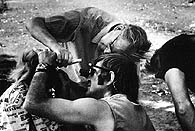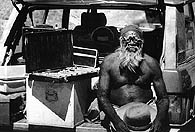
National Trachoma and Eye Health Program
1976
improving eye health in remote communities
Please note the following images may include indigenous people who have died.
In the late 1960s Fred Hollows was working in Sydney as an ophthalmologist. One day he attended a talk about the struggles of the Gurindji workers at Wave Hill cattle station in the Northern Territory. After meeting some of the members of the community, he was invited to visit their home and examine the eye health of the people living there. He found that there was very poor eye health across the community, and there were no appropriate medical services to address the problems. Conditions existed in the Aboriginal community that had not been seen in Western society for generations, the most serious being trachoma.
On returning to Sydney, Hollows spoke out about differences between medical services in the city and the outback, and the discrepancy in eye health between Aboriginal and non-Aboriginal Australians. He became active in promoting Aboriginal health and helped to set up the first Aboriginal Medical Service in Redfern in 1971. This service became a model for Aboriginal Medical Centres around the country.
In 1975, Health Department workers Gordon Briscoe and ?Pip? Ivil approached Fred to discuss what could be done to improve Aboriginal eye health. After initial discussions they approached the government for funding and formed the National Trachoma and Eye Health Program. The Commonwealth government provided $1.4 million to the Royal Australian College of Ophthalmologists to run the program. The aim was to eliminate trachoma in Aboriginal people and screen, diagnose and treat eye diseases throughout rural Australia.
The program involved several teams in four wheel drive vehicles and army tents travelling the country, examining and treating eye problems in the Aboriginal community. Each team employed Aboriginal liaison officers to visit communities and discuss the program with local residents. Eye examinations were carried out, treatments were given and the records of the examination were left with the community. Such a large-scale system to provide specialist health services to remote areas of Australia had not been achieved before.
From 1976 to 1978 the teams screened over 100 000 people (60% of whom were Aboriginal or Torres Strait Islander people) in rural and remote areas of Australia. Similar programs continued in various forms run by Commonwealth, state and regional organisations. As a result the number of Indigenous people suffering curable blindness was halved. Fred Hollows went on to create international programs to treat cataract blindness by training surgeons and producing lenses cheaply.
Who Did It?
Key Organisations
Royal Australian College of Ophthalmologists : staffing and co-ordination of program
Commonwealth Department of Health : funding
Key People
Fred Hollows : ophthalmologist, Director of National Trachoma and Eye Health Program (NTEHP)
Hugh Taylor : ophthalmologist, Assistant Director of NTEHP
Gordon Briscoe : Department of Health, Assistant Director of NTEHP
Dr S I ?Pip? Ivil : Department of Health
Further Reading
Fred Hollows, An autobiography with Peter Corris, Fred Hollows and Peter Corris, John Kerr, Richmond, 1991.
Links
The Fred Hollows Foundation
Royal Australian and New Zealand
College of Ophthalmologists
Eye
Health in Aboriginal and Torres Strait Islander Communities
Fred
Hollows - Australian of the Year 1990
TIME
magazine, October 25, 1999 Vol. 154 No. 17
|












